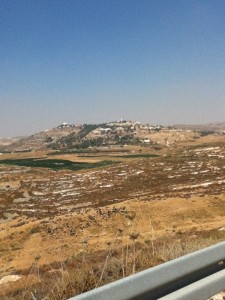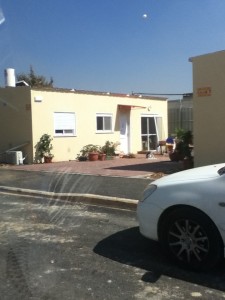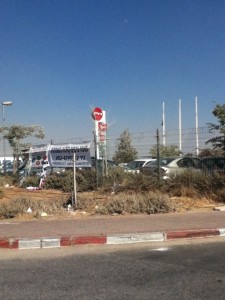When you tour the West Bank, you get a direct sense of the small but shared space in which Israel and the West Bank exist. A recent visit to the latter, led by Lior Amihai of Peace Now, has made me pessimistic that the proximity, even intimacy, between the two still allows for much opening in which to construct a final agreement based on the two-state solution. (For other conclusions see their impressions of the visit written up by Jeremy Pressman and Mira Sucharov.)
When you see the West Bank and talk to Israelis about it, three types of closeness become most apparent. One, a physical closeness.
You can stand on the top of a hill in the West Bank, look up and down along the peaks and valleys, and see the lack of physical space between Palestinian villages and farmland and Israeli towns and outposts.
This is enhanced by the fact that there is no actual demarcation of the West Bank, except for the security barrier or checkpoints in certain areas. But you can drive along a very smooth road (Route 5) from Tel Aviv all the way into Ariel, without knowing when you’ve passed into non-sovereign Israeli-held territory because there is nothing marking the spot.
Two, there is a psychological closeness that structures how Israelis think about the West Bank. Many times I heard from or about Israelis who understand the West Bank might not be legally part of Israel but see no contradiction in or problem with conceiving of it as the same normative space. When academics can’t find jobs, with relief they accept positions at Ariel University Center. When they want a larger backyard and lower cost of housing, they move to Gush Etzion.
More than economics, it is the mental ease of access that compels Israelis to utilize such resources available in the West Bank. It’s not like moving to another country, which would require a major process of application, transportation, and adjustment.
And Israeli settlements, including outposts like Migron, are small and crowded but normal looking, filled with caravan-type houses, their open front yards marked by outdoors chairs and tables for sitting; children walking and playing; wind chimes and name plates hanging outside doors; and so on.
Three, market forces overarch the other two and open up more areas into which Israelis rush. These economic imperatives tie Palestinians, Israelis, and settlers together beyond their political or personal convictions or reticence.
Aroma, the chain of Israeli restaurants popular among diaspora Jews for its super-sized salads, maintains a coffee shop in a gas station in Ariel. (The company selling that gas, too, has stations throughout Israel.) The Palestinian falafel stand right outside Ariel boasts signs in Hebrew and Russian, calling settlers to come and eat because it’s good for business.
All three types of closeness might be facilitated by the Israeli government, but they are maintained and promoted by the average Jewish citizen. And it is this sense of sameness of the two spaces that hampers the separation of them into two viable states.
And yet, Amihai remains optimistic, based on his analysis of public opinion polls and the Gaza disengagement. While many Israelis see the settlers as Zionist pioneers and sympathize with their enterprise, when the state decides to take action in pursuit of a peace treaty with the Palestinians, he contends, the public will follow it rather than the settlers calling for resistance.
Amihai reminds us that excluding Jewish neighborhoods around east Jerusalem, settlers account for only 4% of the population–and that’s including the haredi and quality-of-life settlers who move to the West Bank for economic rather than ideological reasons. In other words, it’s a very, very small minority of Israelis. They cannot stand against the overwhelming bulk of society.
It’s a reasonable claim. I’m not totally convinced, because settlers have many supporters and sympathizers throughout government, the military, and the state bureaucracy; they have institutional support. But for a two-stater like myself, who believes that both Israelis and Palestinians will only be able to live in security and according to their national needs in separate states, I’m willing to build on it out of sheer hope.




And might I point out that in the Binyamin / Ramallah area, we do our grocery shopping together without incident at the local Rami Levy. On vacation time, we kick around in the same springs also without incident. I’m not saying that there isn’t tension around here, but the Arab-Israeli conflict has been greatly magnified by politicians and the press.
Pingback: The Levy Committee’s New-Old Recommendations | Mideast Matrix
Pingback: Debate the Cause and Effects of “Occupation,” But Not Its Existence | Mideast Matrix
Pingback: Shelly Yachimovich’s Balancing Act | Mideast Matrix